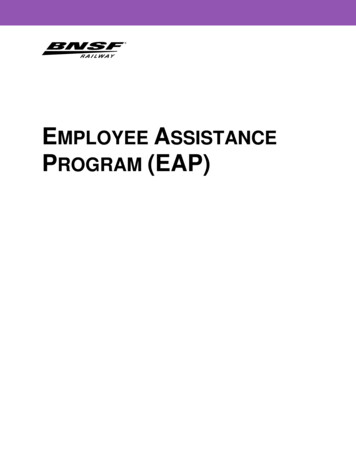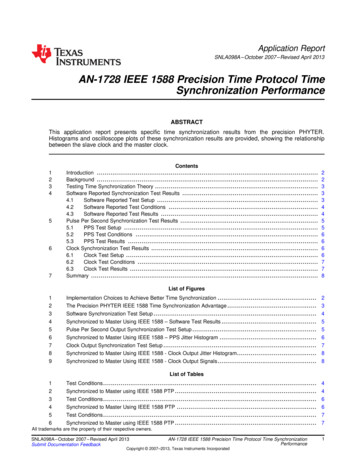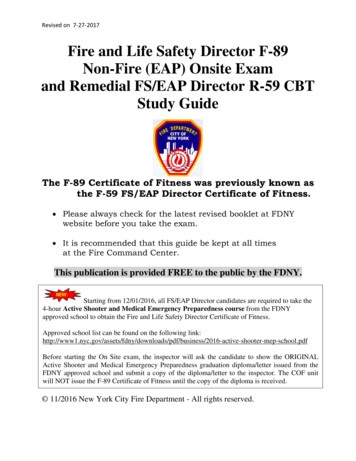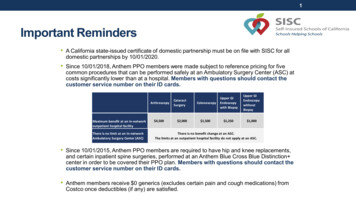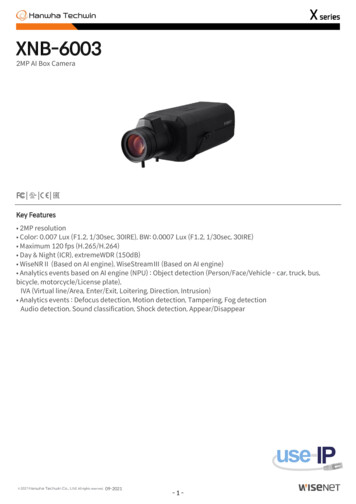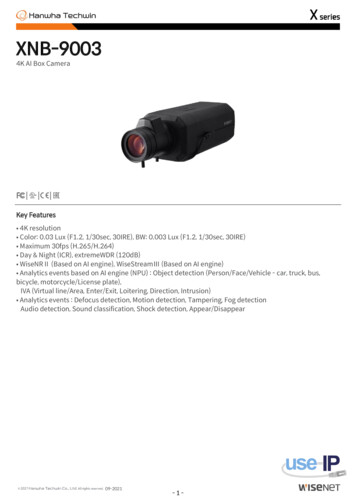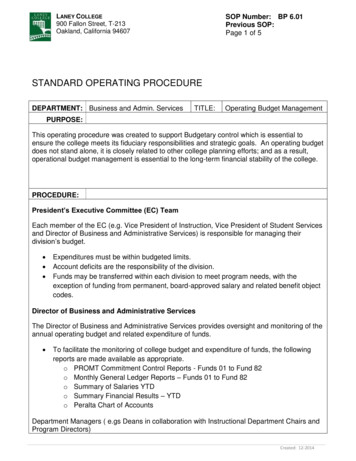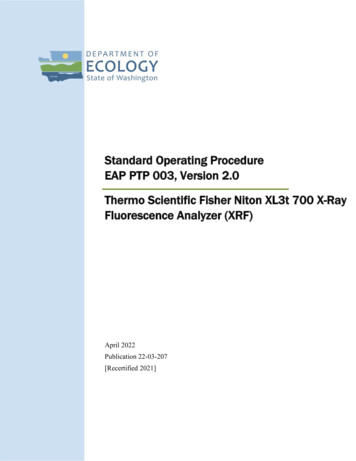
Transcription
Standard Operating ProcedureEAP PTP 003, Version 2.0Thermo Scientific Fisher Niton XL3t 700 X-RayFluorescence Analyzer (XRF)April 2022Publication 22-03-207[Recertified 2021]
Purpose of this DocumentThe Washington State Department of Ecology develops Standard Operating Procedures (SOPs) todocument agency practices related to sampling, field and laboratory analysis, and other aspects of theagency’s technical operations.Publication InformationThis SOP is available on the Department of Ecology’s website Pages/2203207.html.Ecology’s Activity Tracker Code for this SOP is 12-074.Recommended citation:Wiseman, c., 2022. Standard Operating Procedure PTP 003, Version 2.0: Thermo Scientific FisherNiton XL3t 700 X-Ray Fluorescence Analyzer (XRF). Publication 22-03-207. Washington StateDepartment of Ecology, ummaryPages/2203207.html. (Recertified 2021.)Contact InformationPublications CoordinatorEnvironmental Assessment ProgramWashington State Department of EcologyP.O. Box 47600Olympia, WA 98504-7600Phone: 360-407-6764Washington State Department of Ecology – https://ecology.wa.gov Headquarters, Olympia360-407-6000 Northwest Regional Office, Bellevue425-649-7000 Southwest Regional Office, Olympia360-407-6300 Central Regional Office, Union Gap509-575-2490 Eastern Regional Office, Spokane509-329-3400Any use of product or firm names in this publication is for descriptive purposes onlyand does not imply endorsement by the author or the Department of Ecology.To request ADA accommodation for disabilities, or printed materials in a format for the visually impaired, callthe Ecology ADA Coordinator at 360-407-6831 or visit ecology.wa.gov/accessibility. People with impairedhearing may call Washington Relay Service at 711. People with speech disability may call TTY at 877-8336341.
Environmental Assessment ProgramStandard Operating Procedure EAP PTP003Version 2.0Original Author – Sara SekerakDate – 3/9/2018Original Reviewer – Chrissy WisemanDate – 2/23/2018Current Author – Chrissy WisemanDate – 5/31/2021Current Reviewers – Prajwol Tuladhar, Ken NelsonDate – 5/31/2021QA Approval – Arati Kaza, Ecology Quality Assurance OfficerRecertification Date – 6/15/2021Signatures Available Upon RequestThe Washington State Department of Ecology’s (Ecology’s) Standard Operating Procedures (SOPs)are adapted from published methods, or developed by in-house technical and administrative experts.Their primary purpose is for internal Ecology use, although sampling and administrative SOPs mayhave a wider utility. Our SOPs do not supplant official published methods. Distribution of these SOPsdoes not constitute an endorsement of a particular procedure or method.Any reference to specific equipment, manufacturer, or supplies is for descriptive purposes only anddoes not constitute an endorsement of a particular product or service by the author or by Ecology.Although Ecology follows the SOP in most instances, there may be instances in which Ecology uses analternative methodology, procedure, or process.SOP EAP PTP003, Version 2.0Uncontrolled copy when printed — Page 1
SOP Revision ummary of ChangesSectionsReviser(s)NewAllS. SekerakMinor editsFooter, QA approval, minoreditsAdded Ref. Std., Section2.4.2, minor editsCertifiedProcedural edits, newformattingAllAllB. KamminB. KamminAllS. SekerakAllAllTom GriesC. WisemanSOP EAP PTP003, Version 2.0Uncontrolled copy when printed — Page 2
1.0Purpose and Scope1.1This document serves as the Product Testing (PT) Standard Operating Procedure (SOP)for operating the Thermo Scientific Fisher (Thermo) Niton XL3t 700 X-rayFluorescence Analyzer (XRF) in TestAll mode.1.2Warning: The XRF contains an X-ray Tube That Emits ionizing radiation. Thoroughlyreview and comply with all the safety requirements and recommendations outlined inSection 9.0.2.0Applicability2.1This SOP includes procedures for safety, training, verification, limitations, operation,quality assurance and basic maintenance/troubleshooting of the XRF. The SOP shall befollowed when operating the XRF in TestAll mode as a tool to screen for the presenceof certain elements in consumer products, raw materials, and other types of productmaterials.2.2The manufacturer identifies the following elements as measureable using this XRFinstrument:Chlorine (Cl) ***Zinc (Zn)Indium (In)Titanium (Ti) ***Arsenic (As) #Tin (Sn)Vanadium (V)Selenium (Se)Antimony (Sb) #Chromium (Cr)Bromine (Br) ***Barium (Ba)Manganese (Mn)Zirconium (Zr)Tungsten (W)Iron (Fe)Niobium (Nb)Platinum (Pt)Cobalt (Co) *#Molybdenum (Mo)Gold (Au)Nickel (Ni)Silver (Ag)Mercury (Hg) #Copper (Cu)Cadmium (Cd) #Lead (Pb) #* Designates elements that were custom calibrated into the instrument.# designates the PT CSPA target elements.*** Designates the additional PT elements of interest.Note that elements in certain matrices may not be detectable at levels of interest whenusing the XRF in ‘TestAll’ mode.SOP EAP PTP003, Version 2.0Uncontrolled copy when printed — Page 3
2.3This XRF is operated under a ‘Fundamental Parameters Calibration’ mode thattheoretically can see up to a 100% concentration (i.e. pure element) when used inaccordance with the manufacturer recommendations and abiding by known x-rayanalysis limitations.2.4XRF product screening results that follow this SOP (PTP003) are used to help selectsamples to submit for further confirmatory laboratory analysis as well as, research foradditional PT elements of interest.2.5All product screenings for elements must be initially verified by analysis of calibrationverification standards prior to analysis of samples. Identify when the procedure is to befollowed. The primary of suite of standards (Section 6.5.4 Table 1) covers the PT elements ofinterest: Cl, Ti, Cr, Co, As, Br, Cd, Sb, Hg, and Pb. Available calibrationverification standards and their acceptance limits are displayed in Appendix A. A provisional verification standard acceptance limit of 45% is applied to Co due tothe variability observed measuring Co in the available standard. Co data should beused cautiously and any study prioritizing solely on Co should verify instrumentperformance with a second standard, matrix specific, if available.3.0Definitions3.1Component - Individual piece or part of a product containing different colors, functions,and/or material (i.e., a sweater may be comprised of several components such as, thewoven fabric, a button, and zipper pieces).3.2Component Sample - Component identified to be screened as a sample using the XRF.Components cataloged in the PTDB receive an alpha-numeric identification (ID) that isused as the XRF component ID (e.g. TG-1-1-1).3.3Filter - A mechanism built into the instrument that allows modification of the x-rayenergy to preferentially enhance the analysis of certain elements in certain matrices.3.4Fundamental Parameters Calibration – An approach to instrument calibration basedupon the theoretical relationship between measured X-ray intensities and theconcentrations of elements in the sample. This “standard less” approach is commonlyused when there are few to no matrix specific standards available.3.5Ionizing Radiation - Radiation that carries enough energy to free electrons from atomsor molecules, thereby ionizing them. This type of radiation poses risk due to itspotential to alter the chemical structure of living cells.3.6NDT - Niton Data Transfer. The NDT software is used to download data per section5.3 from the XRF to the computer.3.7NDTr - Niton XRF operating software.3.8Laboratory Sample - Component sample identified for testing by a confirmatorylaboratory analysis method (e.g. Environmental Protection Agency (EPA) SW-8466020).SOP EAP PTP003, Version 2.0Uncontrolled copy when printed — Page 2
3.9Limit of Detection (LOD) - The smallest concentration of an element that can bedetected with reasonable certainty. It is generally regarded as indicating whether anelement is present or not, and does not imply that a value obtained is accurate. The LODis numerically expressed as two or three standard deviations measured on a sample withnone or only a trace amount of the analyte present. Since the individual LODs are basedon measurement error, they also improve as a function of the square root of the testingtime.3.10Light Elements - Elements including: Cl, V, Ti, and Cr.3.11Low Filter - the preferred instrument filter used to fluoresce light elements, e.g. Factorydefault; set at 10 seconds analysis time.3.12Main Filter - the preferred instrument filter used to fluoresce the transition elements,which include groups 3-12 on the periodic table. Factory default; set as 50 secondsanalysis time.3.13Primary Beam - The X-ray source directed out of the front of the analyzer. The sourcecontaining the highest dose rates of radiation.3.14Radiation - The emission of energy as electromagnetic waves or as moving subatomicparticles, especially high-energy particles that cause ionization.3.15Shielding -The material that is placed between the analyst and the radiation source (e.g.,isolation/shielding box).3.16TestAll mode - Thermo technology that automatically selects the correct analyticaltesting sub mode (metal, painted metal, thin metal, plastic, PVC plastic, thin plastic,layered materials, and non-metal) for the operator.3.17XRF - X-Ray Fluorescence. The emission of characteristic “secondary” x-rays from asubstance during exposure to an external source of high-energy x-rays.3.18X-Rays - The form of radiant energy and component of the electromagnetic spectrum.X-rays originate from the energy loss associated with the interaction of high energyelectrons or particles with atoms. Define any words, phrases, or acronyms havingspecial meaning or application. Do not assume the reader has special knowledge ofacronyms. Fully state all acronyms before further use.4.0Personnel Qualifications/Responsibilities4.1Always operate the XRF in accordance with this SOP. The SOP is based on theguidance established in the EPA Method 6200 (EPA, 2007) and in accordance with themanufacturer’s instructions and recommendations.4.2All of the Ecology health and safety guidelines described in Section 9.0 must befollowed as specified.4.3All operators must read and understand the Radiation Safety for Thermo ScientificNiton XRF Analyzers (PDF of Slides by James Blute) available in the PT Prep room,and should review the Thermo Fisher Scientific Niton XL3 Analyzer Version 8.0 User'sGuide. (Thermo User’s Guide, 2011)SOP EAP PTP003, Version 2.0Uncontrolled copy when printed — Page 3
4.4The XRF analyst will be responsible for verifying the completeness and correctness ofdata acquisition in accordance with this SOP (PTP003) and any additional guidance preestablished in study-specific QAPP. Errors made during data collection (e.g., sampleID typos, incomplete scans) are recorded in the Error Log and will be corrected prior toupload of the data to the PTDB.4.5The project manager (PM) will inspect datasets uploaded to the PTDB to verifyaccuracy, completeness, and adherence to the specific study criteria.4.6User Training4.6.1Staff must receive training, perform a successful Initial Demonstration of Capability(IDC) prior to operating the XRF. A qualified operator will provide the training. Aqualified operator is a permanent employee that has been trained to operate the XRF byanother qualified operator.4.6.2Permanent employees may also receive training through qualified Thermo techniciansand or formal Thermo training opportunities to become a qualified operator.4.6.3For new analyst training, the overseeing qualified operator will be responsible forsupplying the new analyst with: The Training Checklist and IDC form available in Product Testing Unit (PTU)SharePoint site A copy of this SOP (PTP003) Copies of or links to the documents listed in Section 4.3 Hands on training Administering IDC analysis Continued oversight and review of an analysts first several XRF operation sessions5.0Equipment, Reagents, and Supplies5.1Thermo Scientific Niton XL3t 700 X-ray Fluorescence Analyzer (XRF).5.2Isolation/shielding box with leaded self-closing flaps.5.3Laptop computer with Thermo Scientific NDTr (v. 8.4.1 or newer) operating softwarefor remote XRF operation and NDT (v. 8.4.2 or newer) software for data downloading,Comma Separated Value (CSV) generation, and spectra review.5.4XRF Instrument Logbook for recording daily use (study name, date, Res Value, userinitials). The logbook is to be used to note poor instrument or software performance,preventive maintenance, repairs, and calibration or verification issues.5.5XRF Records Logbook to document training records for certified users, DOH X-raycertification, Software, x-ray tube certification preventive maintenance factory records,repairs, calibrations and verifications.5.6XRF Error Log for recording sample specific errors and to be used for immediatecleanup of data prior to uploading to the PTDB.SOP EAP PTP003, Version 2.0Uncontrolled copy when printed — Page 4
5.7“Small Spot Locator” Sample. Not required.5.8Calibration verification standards containing element(s) of interest.5.9Current available calibration verification standards with certified values and 20%acceptance limits are listed in Appendix A.5.10Other calibration verification and performance check standards may be used to validateand analyze for additional elements. Standards should be certified according theguidance issued in International Organization for Standardization (ISO) Guides 30-35.The materials selected should be sufficiently homogeneous and be analyzed in an “asis” form.5.11XRF sample cups (Thermo Part Number (P/N) 187-466) with Mylar film pre-cutcircles, 6 µm thickness, (Thermo P/N 187-462) or Polypropylene film, 6 µm thickness.5.12The 24% ethanol solution, Liquinox detergent, and de-ionized water (DIW) used fortool cleaning reagents. Additional tool cleaning protocols requiring other reagents mustbe used according to the guidelines set in the Product Collection and Sample ProcessingStandard Operating Procedure (SOP) SOP# PTP001 and study-specific QAPPs. Allapplicable chemical specific health and safety protocols shall be followed.5.13The tools, reagents and supplies described in the current version of the Product TestingSample Collection and Processing SOP# PTP001 will also be used in the deconstructionand preparation of component samples for XRF screening.6.0Summary of Procedure6.1Instrument, Measurement and Data Interpretation Limitations, and Potential Sources ofError6.1.1A visual guide to the basic startup and usage of the XRF instrument is available in PTUSharePoint site.6.1.2The operation of this XRF has been optimized using the TestAll analysis mode.6.1.3The physical structure or composition of samples are often the leading cause in theacquisition of inaccurate results.6.1.4Instrumental limitations of the TestAll mode and sample thickness requirements aredetailed in Appendices B and C.6.1.5Isolation of component samples may be necessary to avoid interference from othersurrounding components.6.1.6Component samples with a heterogeneous composition may produce variable orimprecise results when replicates are performed. Determinations ofhomogeneity/heterogeneity of a sample is often not clearly visible to the eye, forexample, with the compositional metal heterogeneity exhibited in some alloys.6.1.7Liquid or components in powder form may yield results with more certainty whenthoroughly mixed prior to analysis.SOP EAP PTP003, Version 2.0Uncontrolled copy when printed — Page 5
6.1.8Use of the XRF as a screening tool does not require homogenization of a componentsample (e.g., grinding a solid into a powder). Therefore, data for heterogeneouscomponent samples should be interpreted cautiously.6.1.9Component samples exhibiting roughness and uneven surfaces may cause decreasedintensities of results, especially those of light elements. Use the XL3t 970 GOLDD XRF using SOP# PTP004 to optimize screening for light elements.6.1.10Scanning the smoothest portion of a component sample may reduce potential bias of theresults obtained.6.1.11Irregular shapes or objects with curvature (e.g., wine bottles) may require extra-carefulpositioning.6.1.12Several of the same small objects (e.g., earring backings) piled together may lowerpotential bias of the results.6.1.13Containing small objects in a prescreened bag or XRF cup with Mylar (or polyethylene)film and scanning them through the bag/film should be used cautiously as the bag/filmwill decrease the intensity of results, and light elements may go undetected. Bags andfilm used must be pre-screened to show they do not contain target elements.6.1.14The thickness of an object can affect accuracy of results. Low density materials such asplastics and fabric require several millimeters up to a centimeter of material thickness asthe x-rays necessitate an increased depth of penetration to recover elements accurately.Heavier plastics, like polyvinyl chloride (PVC) would require only a few millimetersthickness, and dense metal objects need only a few micrometers thickness. Seethickness recommendations in Appendix C.Note: Materials, such as plastic bags and fabrics, should be folded or stacked asrecommended above or as thick as possible prior to analysis.6.1.15A prescreened non-target element containing heavy object (e.g., a rock) can be utilizedto compress stacked materials. However, caution should be exercised so that the x-raysdo not penetrate the object used to compress the sample.6.1.16Paint and coatings on materials may lower the intensity, concentration, and ability todetect a target analyte in the underlying material.6.1.17It is suggested that replicate analyses of an individual component should be performedto assess the within-sample variability.6.1.18Evaluation of individual component sample spectrum is always advised to verify thepresence or absence of a target element to further aid in confirmatory laboratoryanalysis prioritization and candidacy.6.1.19Guidance for data review including primary wavelength selection, common matrixinterferences, and spectral line overlaps is provided in Appendix D.6.26.2.1Instrument/Analysis PreparationsReview study specific QAPP for additional requirements prior to beginning XRFscreening analyses.SOP EAP PTP003, Version 2.0Uncontrolled copy when printed — Page 6
6.2.2Follow the guidance specified in the PT Sample Collection and Processing SOP (SOP#PTP001) for tool cleaning, glove selection, and product deconstruction protocols.When applicable, follow additional low-level processing and analysis proceduresdescribed in SOP# PTP001.6.2.3Extreme care shall be taken to not introduce contamination or conditions that may affectthe product or product components, and the selection of component samples forconfirmatory laboratory analysis.6.2.4Wear gloves when handling products, components, and component samples for XRFscreening. At a minimum, change gloves when they become soiled or debris is visible.6.2.5Use clean tools for deconstruction of the product and components for screening. Followthe guidance specified in the current version of PT Sample Collection and ProcessingSOP (SOP# PTP001).6.2.6A specific study’s objective, analytes, levels of interest, and/or difficulties encountereddue to a product or component matrix or construction may necessitate a more stringentprotocol for handling, preparing (e.g. deconstruction), and screening componentsamples.6.2.7The isolation/shielding box should be used for most screening. As needed, clean the box(with an ethanol moistened Kim wipe) before the instrument is secured in the test standand/or between sample analyses when loose debris is deposited on the measurementwindow (e.g., fine hairs from stuffed animals, glitter, etc.).6.2.8The XRF is stored in its case nightly in the locked cabinet.6.2.9The XRF case is to be locked when the XRF is transported out of the PT room.6.2.10Room access and cabinet keys are issued to PT personnel only to restrict access to theXRF.6.3Instrument Setup6.3.1Inspect the XRF measurement window for damage (i.e., scratches) and for debris. TheXRF should not be on during the inspection or window replacement.6.3.2Clean the measurement window by blowing air or gently sweeping using KimWipes .Too much pressure applied while wiping may damage the window, requiringreplacement.6.3.3If punctured or wrinkled replace the measurement window (P/N 187-1555) as necessaryfollowing the instructions found in the “Learning More, Service, and Support” sectionof the Niton XL3 user’s guide (Pages 173-175).6.3.4Plug in the USB cable into the mini USB port and the AC cable into the power port.Both ports are located below the XRF LCD screen under the black port cover. Connectthe USB to the adjoining laptop and AC cable into an electrical outlet.6.3.5The battery should not be in the unit when it is used while plugged in. Refer to theUser’s Guide for battery charging when the XRF is used in handheld mode.SOP EAP PTP003, Version 2.0Uncontrolled copy when printed — Page 7
6.3.6Connect the XRF to the isolation/shielding box with the measurement window pointedinto the box and the LCD screen facing toward you. The XRF “clicks” into place whenproperly installed.6.3.7The XRF operates in handheld mode as well. However, most screenings should occurwith the XRF secured in the isolation/shielding box.Note: Place battery into the XRF scanner when using it in hand held mode. It does workwhile plugged to the laptop however this is not recommended because of fragileconnection pins are susceptible to bending.6.3.8Once the USB cable is connected to the adjoining laptop computer open up the NDTrsoftware.6.3.9At the XRF analyzer, hold the ON/OFF/ESCAPE button on the XRF control panel untilthe touch screen comes on. The XRF will take several seconds to start up. The sameprocedure is followed for turning off the instrument.6.3.10After the XRF is powered on, all functions for operating the XRF can occur using theLCD touch screen or the NDTr software on the laptop. For ease of use, it isrecommended that the XRF be operated from the laptop computer using the NDTrsoftware during normal daily use.6.3.11Instructions for operation will hereinafter be described in terms consistent with the XRFwhen controlled by the NDTr software at the laptop.6.3.12From the NDTr software, turn on the camera by selecting the small icon under theHELP tab in the upper right corner. Select the CAMERA icon (TV VIEW). If the XRFis not connecting select to connect and then turn on camera.6.3.13Select PRESS TO LOGON, select YES to proceed through the radiation “Warning”.Enter in the login password: 1234, select ENTER.6.3.14With the camera on the measurement window will be illuminated. Look at the cameradisplay on the NDTr software/Laptop, and re-evaluate the window for scratches anddebris.Note: Verify that the camera image is being saved to the NDT file by selectingSystem/Camera and both Enable Camera, and Save Image boxes should be checked.6.3.15Allow the instrument to warm up for at least five minutes before proceeding to theSystems Check.6.3.16Verify the instrument date and time.6.3.17From menu select SYSTEM, then DATE & TIME.6.3.18Adjust to current date and time if necessary, select SAVE to exit the screen orCANCEL if date and time are correct.6.3.19Select RETURN to get back to Main Screen.6.46.4.1System CheckThe XRF systems check is used to standardize the detector. It must be performed dailyupon use of the XRF.SOP EAP PTP003, Version 2.0Uncontrolled copy when printed — Page 8
6.4.2Perform the XRF systems check by navigating through the main menu. Select SYSTEMCHECK, then select YES.Note: During analysis and detector calibrations, it is important to ensure that theanalyzer is not exposed to strong electromagnetic fields, including those produced byhard drives, cellular telephones, etc. All electronics should be kept at least two feetaway.6.4.3If the system check is performed adequately the message “System Ok” will bedisplayed. Select CLOSE to exit.6.4.4The system check results will be reported out in the final data exported from the XRF.The value is listed as “Res.” The system check logs a detector calibration value foreach occurrence it is performed and reports one sum "Res" value. A detector calibrationresults “Res value” below 195 is considered to be within manufacturer’s optimumspecification.6.4.5If an error message is displayed in the System Check dialogue box, consult the User’sGuide for assistance. A RECHECK may be performed if the selection is available (viaa pop-up box).6.4.6Record any error messages received in the XRF Instrument Logbook. An analysissession shall not proceed if there is not a successful system check performed. ConsultThermo for technical assistance.6.4.7At the end of an analysis session record the “Res” value, in the XRF InstrumentLogbook.6.4.8The “Res” value is located on the NDT file download in the “System Check” sampledata. This can be checked during the scanning session by clicking on view data icon andnavigating through the readings.6.4.9The instrument operation specification values can be reviewed at any time duringanalysis by navigating to the main menu and selecting SYSTEM, and then SPECS. Thedisplay will show the instrument Specifications, including when the last system checkwas performed, e.g. “Energy Cal: 12/06/16”. Select - icon to proceed to thediagnostics on page two to view the operating specifications.6.5Daily Calibration Verification Standards and Sample Screening6.5.1Prior to any unknown sample analyses, perform the initial XRF daily calibrationverification with certified standards. Matrix specific standards should be analyzed inorder to meet the objectives of the study specific QAPPs.6.5.2Scan the following suite of standards for CHCC (Chemicals of High Concern forChildren’s) metals list: As, Cd, Co, Hg, Sb, and Pb. Thermo Scientific Niton Polyethylene (STD-1-1-2) MBH Metals Standard (STD-1-1-3) Calmetrics Polyethylene Blank (STD-1-2-3) Calmetrics PVC Low Standard (STD-1-3-2)SOP EAP PTP003, Version 2.0Uncontrolled copy when printed — Page 9
6.5.36.5.4MBH Metal Standard (STD-1-5-1)The following suite of standards will be analyzed for Flame Retardant Studies of whenscanning for light elements like Phosphorus. (Applicable only to the XRF GOLDD ) Calmetrics PE Blank(STD-1-6-1) Calmetrics PE Low(STD-1-6-2) Calmetrics PE High(STD-1-6-3)The following suite of standards will be analyzed for Studies scanning for Titanium. MBH Metals Standard (STD-1-4-1) MBH Metal Standard (STD-1-5-1)6.5.5Standard acceptance ranges are 20% for all elements. A full list of availablestandards with certified concentrations and acceptance limits is available in AppendixA.6.5.6If a target element of interest in a standard fails to meet acceptance criteria at thebeginning of the analysis session rescan the specific standard. If this does not work, reperform the XRF system check (Section 6.4) and reanalyze all of the required standards(Section 6.5.2 -6.5.4).6.5.7 If the element fails to meet acceptance criteria for a second time, alert PM via emailat the end of the scanning session. Record standard/element failure in XRF Instrument Logbook.The suite of study specific standards listed in 6.5.2 -6.5.4 are to be run at the beginningand end of every XRF scanning session (scanning session is a consecutive time periodin which the XRF is run) or as specified in Study QAPP. Table 1 provides an exampleof Verification Standards selected to represent a variety of matrices for an XRFScanning session.Table. 1 Example CHCC XRF Suite of Daily Calibration Verification standards, and BlanksmmMatrixElementsStd-1-1-2PolyethyleneAs, Cd, Cr, Hg, Pb, SbStd-1-1-3Metal (tin)Ag, Cd, Cu, PbStd-1-2-3PolyethyleneNone (Blank)Std-1-3-2PVCBr, Cd, Cl , Cr, Hg, Pb,Std-1-5-1Metal (Si/Al/ Cu)Cr, Co, Ti Certified value for Co is less than XRF LOD.SOP EAP PTP003, Version 2.0Uncontrolled copy when printed — Page 10
Cl does not have a certified value; PVC matrix contains 15% Cl. PVC/Cl is used tovalidate the instruments capability to detect and delineate PVC- based plastics.6.5.8Matrix specific standards should be analyzed in addition to the primary suite ofstandard, when such standards exist, and as described in study specific QAPPs.6.5.9Matrix specific element optimization calibrations can be performed when matrixspecific standards are available in a set. The set must contain multiple concentrationlevels and include a blank. Consult the User’s Guide for instructions and applicability.6.5.10Consult study specific QAPPs for additional standards or frequency to perform checkstandard analyses during an XRF screening session.6.6Ready to Test6.6.1Verify that the camera has been turned on and the System Check has been performed.6.6.2Select Sample Type, Consumer Goods and TestAll to navigate to the TestAll mode. AllPT screening analyses (and their associated verification standards) will use the Test Allmode unless otherwise specified in a study specific QAPP.6.6.3In the TestAll mode, from the Ready to Test screen select DATA ENTRY Select theVIRTUAL KEYBOARD to type the standard ID (e.g. STD-1-1-3) into the SAMPLEentry box or use the dropdown arrow to highlight standard.Note: The suite of standards are pre-programmed into the XRF. Under the VIRTUALKEYBOARD select the dropdown menu bar to choose the appropriate standard.6.6.4Next, select the dropdown arrow under the Model entry box. Highlight the equipmentin use (XRF XL3t 700 or the loaner XRF XL3t 700) and select RETURN. The XRFwill maintain the model selection for the duration of the scanning session.6.6.5Place the required standard into the isolation/shielding box centered over themeasurement window. The camera should be used to verify the sample is appropriatelyplaced and the desired a
3.6 NDT - Niton Data Transfer. The NDT software is used to download data per section 5.3 from the XRF to the computer. 3.7 NDTr - Niton XRF operating software. 3.8 Laboratory Sample - Component sample identified for testing by a confirmatory laboratory analysis method (e.g. Environmental Protection Agency (EPA) SW-846 6020).
